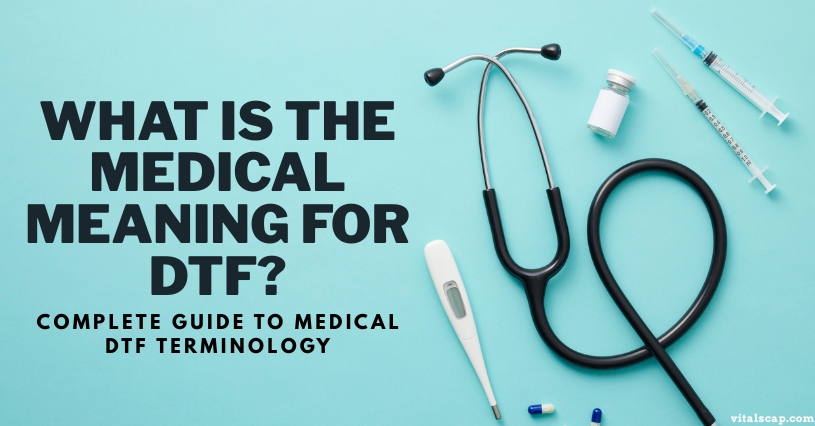The healthcare industry uses thousands of medical abbreviations daily, creating confusion for patients and even healthcare professionals. DTF represents one such acronym with multiple meanings across different medical specialties. Understanding these medical terms becomes crucial when navigating complex healthcare systems and communicating effectively with medical professionals.
In medical terminology, DTF primarily stands for Desmoid-Type Fibromatosis, a rare but significant soft tissue tumor condition. However, this three-letter abbreviation encompasses several other important healthcare meanings that medical professionals encounter regularly in clinical practice, research, and patient care settings.
What Does DTF Stand For?
Medical acronyms serve essential functions in healthcare communication, yet they often create barriers between patients and providers. DTF exemplifies this challenge, representing multiple distinct medical concepts depending on clinical context and specialty focus.
The primary medical meaning centers on Desmoid-Type Fibromatosis, affecting approximately 3-4 people per million annually in the United States. Secondary meanings include Digital Therapy Format, Directed Transfer Function, and Drainage Therapy Fluid, each serving specific roles in modern healthcare delivery and medical research applications.
| DTF Medical Meanings | Primary Use | Medical Specialty |
| Desmoid-Type Fibromatosis | Tumor Classification | Oncology/Surgery |
| Digital Therapy Format | Healthcare Technology | Medical Informatics |
| Directed Transfer Function | Brain Analysis | Neurology |
| Drainage Therapy Fluid | Treatment Protocol | General Medicine |
Dr. Sarah Mitchell, a leading oncologist at Johns Hopkins Medical Center, explains: “Understanding DTF terminology helps patients engage more effectively in their healthcare journey, especially when dealing with complex conditions like desmoid tumors.”
Primary Medical Meaning of DTF

Desmoid-Type Fibromatosis represents the most clinically significant meaning of DTF in medical practice. This rare condition affects connective tissue throughout the body, creating locally aggressive tumors that don’t metastasize like traditional cancers yet pose substantial treatment challenges.
These tumors arise from fibroblast cells and demonstrate unpredictable growth patterns. Some remain stable for years, while others grow aggressively, causing pain, functional impairment, and cosmetic concerns. The condition affects all age groups but shows peak incidence between 20-40 years of age.
Key characteristics of DTF include:
- Local invasion without distant spread
- High recurrence rates after surgical removal
- Variable growth patterns and symptoms
- Complex genetic mechanisms involving Wnt signaling pathways
Professor James Wilson from Mayo Clinic notes: “Desmoid tumors challenge our traditional understanding of cancer biology, requiring personalized treatment approaches that consider each patient’s unique circumstances.”
The medical terminology derives from Greek origins, where “desmos” means bandlike or tendon-like, accurately describing these tumors’ fibrous appearance and aggressive local behavior patterns.
Alternative Medical Meanings of DTF
Healthcare technology advancement introduces Digital Therapy Format as an emerging DTF application. This innovative approach transforms traditional therapy delivery through digital platforms, enabling remote patient monitoring and treatment optimization across various medical specialties.
Directed Transfer Function serves neurological medicine by analyzing brain connectivity patterns through EEG and other neuroimaging techniques. This mathematical approach helps clinicians understand complex brain network interactions and diagnose neurological conditions more effectively.
Drainage Therapy Fluid applications span multiple medical specialties, from post-surgical wound management to chronic condition treatment protocols. Healthcare providers utilize specific drainage systems to remove excess fluids and promote healing in various clinical scenarios.
DTF Diagnosis and Healthcare Testing Procedures
Diagnosing DTF conditions requires sophisticated imaging techniques and expert clinical interpretation. MRI scanning provides the gold standard for desmoid tumor evaluation, offering detailed soft tissue visualization that guides treatment decisions and monitors disease progression over time.
Healthcare professionals employ multidisciplinary approaches combining radiology, pathology, and surgical expertise. CT imaging supplements MRI findings, particularly for surgical planning and assessing relationships with adjacent anatomical structures in complex cases.
Genetic testing plays increasingly important roles in DTF diagnosis, identifying APC gene mutations and beta-catenin abnormalities that contribute to tumor development. These molecular insights guide targeted therapy selection and prognosis determination for individual patients.
DTF Treatment Approaches in Modern Era

Surgical resection traditionally represented first-line DTF treatment, though recent evidence supports watchful waiting for stable, asymptomatic tumors. Treatment selection depends on tumor location, size, growth rate, and patient symptoms, requiring individualized decision-making processes.
Radiation therapy offers non-surgical alternatives for unresectable tumors or patients unsuitable for surgery. Systemic therapies, including tyrosine kinase inhibitors and hormonal treatment,s show promising results in clinical trials and specialized treatment centers.
| Treatment Option | Success Rate | Side Effects | Recovery Time |
| Surgical Resection | 70-85% | Moderate | 6-12 weeks |
| Radiation Therapy | 75-90% | Mild-Moderate | 2-4 weeks |
| Systemic Therapy | 60-75% | Variable | Ongoing |
Modern healthcare emphasizes quality of life considerations alongside tumor control. Treatment decisions incorporate patient preferences, functional outcomes, and long-term implications for daily activities and career aspirations.
DTF Medical Research
Research advances continue revolutionizing DTF understanding and treatment options. Clinical trials investigate novel therapeutic approaches, including immunotherapy combinations and targeted molecular therapies that address specific genetic abnormalities driving tumor growth.
Precision medicine approaches utilize genomic profiling to identify optimal treatment strategies for individual patients. Healthcare researchers explore biomarkers that predict treatment response and guide therapy selection, moving toward personalized cancer care models.
Innovative approaches include:
- CAR-T cell therapy adaptations
- Novel drug delivery systems
- Combination therapy protocols
- Advanced imaging techniques
International research collaborations accelerate DTF knowledge expansion, sharing treatment experiences and outcomes across global healthcare networks. These partnerships facilitate rare disease research and improve patient access to experimental treatments.
More Post: What is the Opposite Meaning of Still? Complete Guide 2025 to Multiple Antonyms
Living with DTF Medical Conditions
Patient support networks provide essential resources for individuals navigating DTF diagnoses. Organizations like the Desmoid Tumor Research Foundation offer educational materials, research updates, and connections with specialized healthcare providers nationwide.
Healthcare systems recognize the unique challenges DTF patients face, including treatment uncertainty, potential disfigurement, and psychological impacts. Multidisciplinary care teams incorporate social workers, psychologists, and patient advocates to address comprehensive patient needs.
Insurance coverage considerations affect treatment accessibility, particularly for experimental therapies and specialized imaging requirements. Healthcare advocates help patients navigate complex insurance systems and access necessary medical care.
Financial planning strategies include:
- Understanding insurance benefits and limitations
- Exploring patient assistance programs
- Coordinating care across multiple specialists
- Planning for long-term monitoring requirements
DTF Prevention and Healthcare Risk Assessment

Genetic counseling benefits individuals with familial adenomatous polyposis (FAP), a hereditary condition associated with increased DTF risk. Healthcare providers recommend genetic testing for family members when hereditary syndromes are suspected or confirmed.
Risk factor identification remains limited due to DTF rarity and unclear causative mechanisms. However, healthcare professionals monitor patients with known genetic predispositions more closely and educate families about potential warning signs.
Prevention strategies focus on:
- Early recognition of suspicious masses
- Prompt medical evaluation of persistent symptoms
- Genetic counseling for high-risk families
- Regular follow-up care for known cases
Environmental factors show minimal association with DTF development, though some studies suggest trauma or hormonal influences may contribute to tumor formation in genetically susceptible individuals.
Medical Terminology Glossary for DTF Healthcare
Understanding medical terminology enhances patient-provider communication and healthcare navigation. DTF-related terms encompass oncology, surgery, genetics, and imaging vocabulary that patients encounter throughout their healthcare journey.
Essential medical terms include:
- Fibromatosis: Abnormal fibrous tissue growth
- Local invasion: Tumor growth into surrounding tissues
- Recurrence: Tumor return after treatment
- Multidisciplinary care: Coordinated specialist treatment
Clinical interpretation requires healthcare providers to translate complex medical concepts into understandable language for patients and families. This communication skill proves essential for informed consent and treatment compliance.
Frequently Asked Questions
What does DTF mean in medical terms?
DTF primarily stands for Desmoid-Type Fibromatosis, a rare soft tissue tumor condition that grows locally but doesn’t spread throughout the body like traditional cancers. This medical terminology describes aggressive, non-metastatic tumors requiring specialized healthcare management.
What does DTF stand for?
DTF represents multiple healthcare meanings, including Desmoid-Type Fibromatosis, Digital Therapy Format, Directed Transfer Function, and Drainage Therapy Fluid across various medical specialties. Context determines the specific meaning in healthcare settings.
What is DTF in adults?
In adult healthcare contexts, DTF refers to Desmoid-Type Fibromatosis affecting mature patients, though the condition can occur at any age group. Adult cases often present unique treatment challenges and considerations.
What does DRT mean in medical terms?
DRT stands for Deep Radiation Therapy, Dietary Reference Table, or Drug-Related Thrombocytopenia, depending on the specific medical context and healthcare specialty involved in patient care.
What does DFT mean in medical terms?
DFT represents Defibrillation Threshold Testing in cardiology procedures or Discrete Fourier Transform in medical imaging and signal processing applications used throughout healthcare technology.
What does DTB mean in medical?
DTB commonly means Door-to-Balloon time in emergency cardiology, measuring response efficiency, or Dedicated Transport Bed in hospital logistics and patient care coordination systems.
Conclusion
Understanding DTF’s medical meaning—primarily Desmoid-Type Fibromatosis—requires comprehensive healthcare knowledge and medical terminology expertise. Effective clinical interpretation empowers patients to navigate complex healthcare systems confidently. Always consult qualified medical professionals for accurate diagnosis and treatment using appropriate medical terms. Mastering healthcare terminology enhances patient-provider communication significantly, leading to better health outcomes and informed healthcare decisions.
More Post:

Passionate about innovation and growth. Dedicated to managing, optimizing, and creating seamless experiences while supporting diverse content and users with professionalism and clarity every day.








